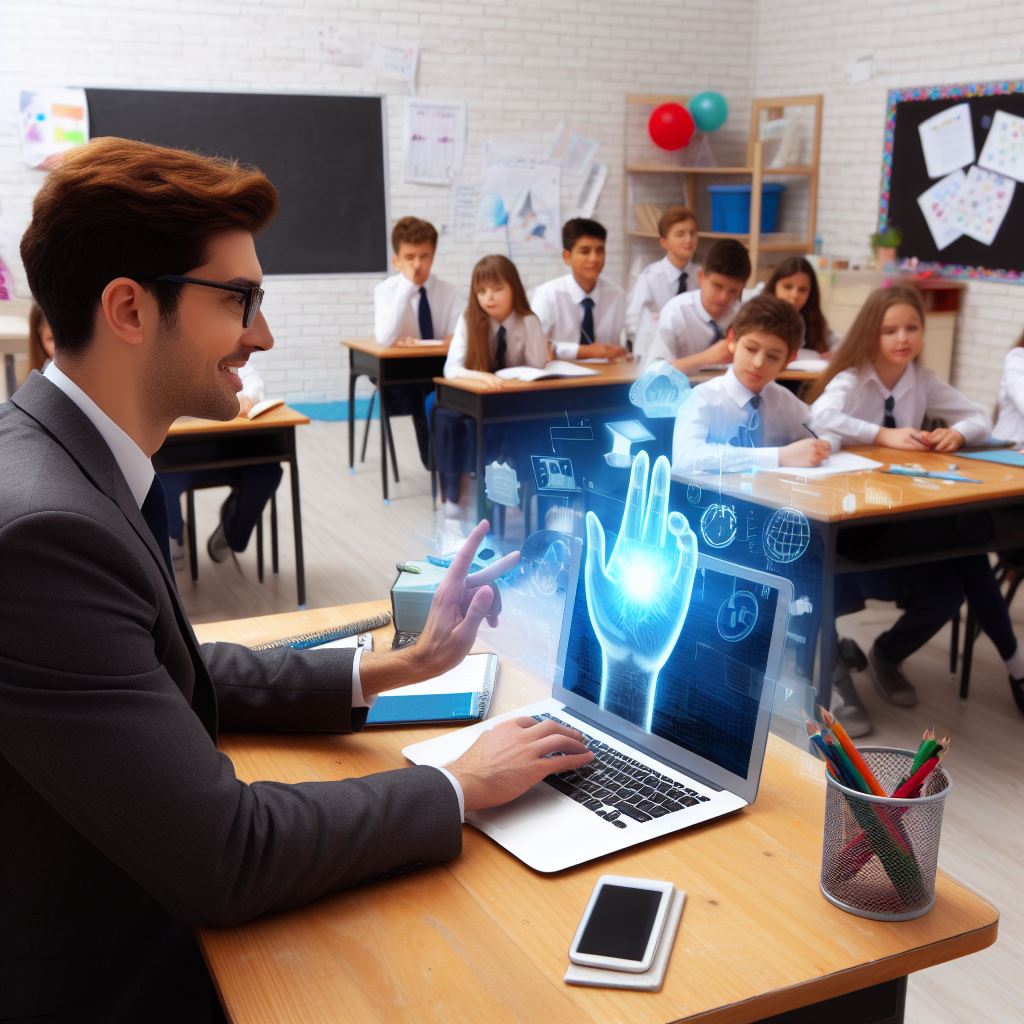Introduction
The impact of technology on the US teaching profession is substantial. Digital tools revolutionize classrooms, altering teaching approaches.
Discussing this is crucial in today’s digital age, ensuring educators adapt to modern teaching trends.
The digital era changes how students learn and how teachers impart knowledge.
Technology influences curriculum and methods, fostering interactive learning for better engagement and understanding.
With technology, classrooms transcend traditional boundaries, offering limitless resources and educational opportunities.
The blog will explore technology’s role in reshaping the educational landscape.
This comprehensive analysis will aid educators in embracing technological advancements effectively.
Understanding technology’s transformative role is crucial in equipping teachers for effective instruction.
As technology becomes a pillar in education, its implications are profound. Embracing technology benefits both educators and students, impacting future generations.
Hence, delving into this discussion is essential for teachers and the educational system.
History of technology in education
Technology has had a profound impact on the teaching profession in the United States.
Over the years, there have been significant advancements in educational technology, which have transformed the way teachers teach and students learn.
The timeline of technological advancements in education in the US
- 1890-1910: Lantern slides and film strips were used in classrooms for visual aids.
- 1920s-1930s: Radio broadcasting allowed for educational programs to be broadcast.
- 1950s: Overhead projectors became popular in schools for displaying content.
- 1960s: The introduction of television brought educational programs into classrooms.
- 1970s: The first computers were introduced in schools, though they were not widely adopted.
Introduction of computers, smartboards, and Internet access in classrooms
- 1980s: Computers became more accessible and were used for computer-assisted instruction.
- 1990s: The internet revolutionized education by providing access to vast amounts of information.
- Early 2000s: Smartboards started appearing in classrooms, allowing interactive teaching.
- Mid-2000s: Laptops and tablets became popular tools for student learning.
- 2010s: The integration of online learning platforms and virtual reality in education.
Technology’s evolution in education began with basic tools like lantern slides, advancing through computers in the 1970s.
The internet revolutionized learning in the 1990s, followed by smartboards, laptops, and tablets.
Advancements in online learning and virtual reality have improved student engagement with interactive lessons.
Yet, teachers face the challenge of continually updating skills to integrate these technologies effectively.
A digital divide exacerbates educational inequalities when students lack access to technology at home.
The timeline of technology in education, from lantern slides to virtual reality, highlights its significant impact on the teaching profession.
Teachers have consistently adapted and embraced these advancements to enrich their teaching methods and enhance student learning.
Read: The Role of Teachers’ Unions in American Education
Transform Your Career Today
Unlock a personalized career strategy that drives real results. Get tailored advice and a roadmap designed just for you.
Start NowAdvantages of technology in teaching
Positive effects of technology on teaching methods
Technology has revolutionized the way teachers impart knowledge, bringing numerous benefits to the teaching profession.
It has enhanced traditional teaching methods and opened new avenues for educators.
Making learning more engaging and interactive
One of the significant advantages of technology in teaching is its ability to make learning more interactive and engaging.
With the use of multimedia, videos, and interactive applications, students can actively participate in the learning process.
Technology encourages student-centered learning and allows students to explore concepts at their own pace.
Expanding access to educational resources
- Technology has immensely expanded access to educational resources, breaking down barriers of time and location.
- Through online platforms and digital resources, students can access a wide variety of learning materials.
- This has particularly benefited students in remote areas or those who cannot afford traditional textbooks.
Technology has greatly influenced the teaching profession by improving methods, engaging learners, broadening resource access, and empowering educators.
Educators can create inclusive, dynamic learning environments by embracing technology, and preparing students for the 21st century.
Read: Overview: The Evolution of Teaching in the USA
Challenges Faced by Teachers in Incorporating Technology
Technology plays a crucial role in the modern and evolving educational landscape.
However, the integration of technology into teaching practices poses several challenges for educators.
These challenges hinder the seamless incorporation of technology, limiting its full potential in the teaching profession.
Difficulties in Integrating Technology
- Lack of technical knowledge and skills can hinder educators from effectively incorporating technology into their teaching practices.
- Resistance to change among teachers can impede the adoption of new technologies, as they may be comfortable with traditional teaching methods.
- Inadequate training and professional development opportunities limit teachers’ ability to adapt to new technologies and integrate them into their classrooms.
- The fear of technology replacing traditional teaching methods leads some teachers to resist its integration, fearing a loss of control or personal touch.
- Time constraints within the curriculum can make it challenging for educators to find time to explore and implement technology seamlessly.
Learning Curve Associated with Using New Technologies
- Learning how to effectively use and navigate new technologies can be time-consuming and require additional effort and training.
- Teachers may feel overwhelmed by the constant need to update their knowledge and skills as new technologies emerge.
- The complexity of some technological tools and applications can create a steep learning curve, especially for less tech-savvy educators.
- Finding appropriate educational resources and digital materials suitable for different subjects and age groups can be challenging.
- Addressing technological issues and troubleshooting problems during class time can be disruptive and impact the flow of the lesson.
Accessibility and Equitability in Technology Implementation
- Unequal access to technology among students and schools can limit the effectiveness of incorporating technology in teaching.
- Financial constraints may prevent some schools from acquiring the necessary devices and infrastructure to support technology integration.
- Poor internet connectivity and unreliable technology limit technology use, especially in rural or low-income areas.
- Inequitable access to technology can create a digital divide, exacerbating existing educational inequalities among students.
- Poor internet connectivity and unreliable technology limit technology use, especially in rural or low-income areas.
Equal access to technology for all students, irrespective of socio-economic status or disabilities, is a persistent challenge.
Overcoming these challenges requires targeted support, professional development, and equitable access to resources and infrastructure.
Equal access to technology for all students, irrespective of socio-economic status or disabilities, is a persistent challenge.
Read: Exploring Career Growth Paths for School Administrators

Training and Professional Development for Teachers
Effective use of technology in the classroom requires adequate training programs for teachers.
Teachers play a crucial role in staying up-to-date with technological advancements.
Professional development opportunities are of utmost importance to enhance teaching skills.
The Need for Adequate Training Programs
- Teachers need comprehensive training to effectively integrate technology into their teaching methods.
- Training programs should focus on developing teachers’ digital literacy skills.
- Teachers must learn how to use various technological tools and software for educational purposes.
- Adequate training can help teachers overcome barriers to technology integration in the classroom.
- It is essential to provide ongoing support and training to ensure teachers feel confident and competent in utilizing technology.
The Role of Educators in Staying Up-to-Date
- Teachers should actively seek information about technological advancements in the education field.
- They need to attend workshops, conferences, and webinars to keep themselves updated.
- Engaging in professional learning communities can help educators stay abreast of new technologies.
- Teachers should regularly explore educational technology resources to enhance their teaching practices.
- Networking with other educators can provide valuable insights into technology integration strategies.
The Importance of Professional Development Opportunities
- Professional development opportunities equip teachers with the necessary skills and knowledge to use technology effectively.
- Continuous learning ensures teachers can adapt to advancements in educational technology.
- Professional development allows teachers to discover innovative ways to engage students using technology.
- It encourages a growth mindset among educators, fostering a culture of continuous improvement.
- Professional development helps teachers understand the ethical and responsible use of technology in the classroom.
In fact, training and professional development programs are vital for teachers to effectively utilize technology in their classrooms.
Showcase Your Business Today
Reach thousands of readers actively exploring professional services. Publish your business profile and grow your audience now.
Publish NowAdequate training programs can equip teachers with the necessary skills to integrate technology seamlessly into their teaching methods.
Equal access to technology for all students, irrespective of socio-economic status or disabilities, is a persistent challenge.
Professional development opportunities provide teachers with the chance to enhance their teaching skills and embrace innovative strategies.
By investing in training and professional development, we can support teachers in becoming tech-savvy educators who empower students through the use of technology.
Read: Handling Parent & Teacher Conflicts: Best Practices
Impact of technology on student learning
Analyze the positive effects of technology on student engagement and learning outcomes
Technology has had a profound impact on student learning, revolutionizing the traditional classroom setting:
- Increased engagement: Technology provides interactive and immersive learning experiences, capturing students’ attention.
- Access to information: The internet allows students to access a wealth of information, enhancing their understanding of subjects.
- Collaboration: Technology enables students to collaborate with peers on projects, developing teamwork and communication skills.
- Individualized learning: Adaptive software tailors lessons to individual student needs, catering to different learning styles.
- Immediate feedback: With technology, students receive instant feedback on assignments, helping them identify areas of improvement.
The potential for personalized and adaptive learning experiences
Technology has the potential to revolutionize education by offering personalized and adaptive learning experiences:
- Customization: Adaptive learning software can adapt to individual student strengths and weaknesses, providing tailored lessons.
- Self-paced learning: Students can learn at their own pace, reviewing or advancing through material as needed.
- Flexibility: Online platforms allow students to learn anytime and anywhere, accommodating different schedules and preferences.
- Individual feedback: Adaptive systems can provide personalized feedback, guiding students towards areas that need improvement.
- Increased motivation: Personalized learning experiences inspire students, making education more engaging and enjoyable.
The influence of technology in preparing students for the digital workforce
Technology plays a crucial role in preparing students for the demands of the digital workforce:
- Digital literacy skills: Technology integration in classrooms enhances students’ digital literacy skills, vital in today’s job market.
- Technical proficiency: Students gain proficiency in using various digital tools and software necessary for future careers.
- Collaborative skills: Technology promotes collaboration, essential for working in teams in the digital workforce.
- Problem-solving abilities: Students develop critical thinking and problem-solving skills through technology-based projects.
- Adaptability: Exposure to technology prepares students to adapt to the ever-changing digital landscape in their careers.
In short, technology significantly enhances student learning, providing engagement, personalization, and preparation for the digital workforce.
Embracing technology in education is crucial for empowering students to thrive in the 21st century.
Concerns and risks related to technology in education
The potential drawbacks and risks associated with the use of technology in the teaching profession
Technology has undoubtedly revolutionized the field of education, bringing numerous benefits and opportunities.
However, it also raises concerns and poses some risks that need to be carefully addressed.
One of the primary concerns is the potential drawbacks and risks associated with the use of technology in the teaching profession.
While technology can enhance teaching and learning experiences, it can also have negative impacts.
For instance, relying too heavily on technology might lead to a loss of human interaction, which is crucial for effective education.
Concerns about student privacy and data security
A major concern that arises with the integration of technology in education is student privacy and data security.
As students increasingly use technology for learning purposes, their personal information can be at risk of being compromised.
Educational institutions must ensure robust security measures are in place to protect student data.
The potential for increased screen time and the impact on student well-being
- Additionally, the potential for increased screen time is a growing concern in the digital age.
- With online learning and the use of digital devices becoming more prevalent, students may spend extended periods of time staring at screens.
- This excessive screen time can have adverse effects on their well-being and overall health.
- Increased screen time can lead to various issues such as eye strain, sleep disorders, and sedentary behavior.
- Moreover, constant exposure to screens can negatively impact students’ attention spans and ability to focus.
- It is essential for educators to find a balance between incorporating technology and promoting healthy screen habits.
- Furthermore, the psychological and social impact of excessive technology use cannot be disregarded.
- Excessive screen time can contribute to feelings of isolation and detachment from the real world, potentially affecting students’ mental health.
- It is crucial for educators to cultivate a healthy and balanced learning environment to mitigate these risks.
Equal access to technology for all students, irrespective of socio-economic status or disabilities, is a persistent challenge.
Educators must strive to strike a balance between leveraging technology for educational purposes and maintaining human interaction.
They should also prioritize student privacy and data security and be mindful of the potential negative effects of increased screen time on student well-being.
By addressing these concerns, technology can truly enhance the educational experience and prepare students for the challenges of the digital era.
Conclusion
The impact of technology on the US teaching profession cannot be ignored.
While technology offers numerous benefits, such as increased engagement and access to information, it also poses challenges.
It is crucial to find the right balance between technology and traditional teaching methods.
Finding this balance is important because while technology can enhance learning experiences, it should not replace the fundamental aspects of teaching.
Human interaction, critical thinking, and personalized instruction are irreplaceable in the learning process.
The future of technology in the US teaching profession seems promising.
As technology continues to evolve, educators will have even more tools at their disposal to create innovative and engaging learning environments.
However, it is essential to remember that technology is merely a tool. The responsibility lies with teachers to use it effectively and adapt it to their students’ needs.
It is also important to address the potential drawbacks and limitations of technology.
Over-reliance on technology can lead to decreased face-to-face interaction, limited social and emotional development, and potential equity issues.
Teachers must be mindful of these challenges and take proactive steps to mitigate them.
The integration of technology into the US teaching profession has the potential to revolutionize education.
It offers limitless possibilities for personalized learning, collaboration, and global connections.
However, it is crucial to remember that technology should complement, not replace, effective teaching practices.
Achieving the right balance between technology and traditional teaching methods is key to ensuring high-quality education for all students.
[E-Books for Sale]
The Big Book of 500 High-Paying Jobs in America: Unlock Your Earning Potential
$19.99 • 500 High-Paying Jobs • 330 pages
Explore 500 high-paying jobs in America and learn how to boost your career, earn more, and achieve success!
See All 500 High-Paying Jobs of this E-Book
1001 Professions Without a Degree: High-Paying American Jobs You Can Start Now
$19.99 • 1001 Professions Without a Degree • 174 pages
Discover 1001 high-paying jobs without a degree! Unlock career tips, skills, and success strategies for just $19.99!




